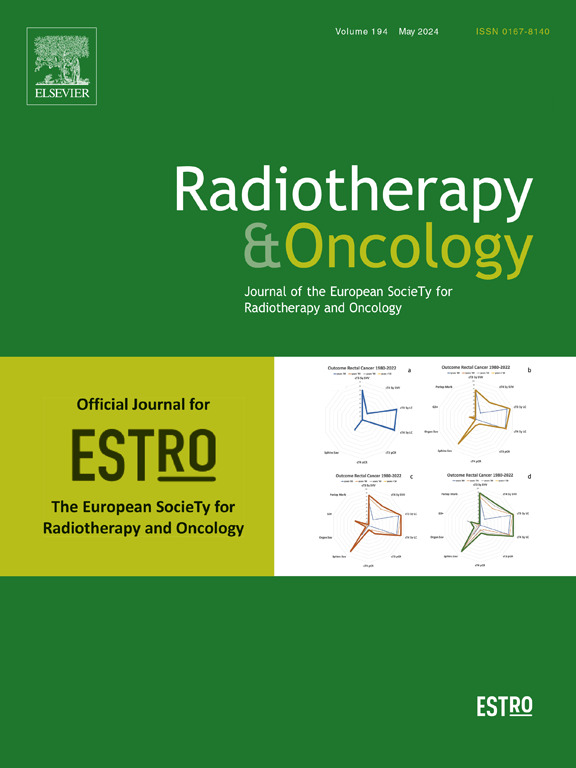The role of prophylactic cranial irradiation in patients with limited-stage small cell lung cancer at different risks of brain metastasis: A multicenter retrospective study
IF 4.9
1区 医学
Q1 ONCOLOGY
引用次数: 0
Abstract
Background and purpose
To evaluate the value of prophylactic cranial irradiation (PCI) in patients with limited-stage small cell lung cancer (LS-SCLC) at different risks of brain metastasis (BM).
Materials and methods
A retrospective study included 498 LS-SCLC patients from three centers who achieved complete or partial response (CR/PR) after radical chemoradiotherapy. A nomogram was developed using significant factors associated with BM, identified through univariate and multivariate analyses. Patients were stratified into high- and low-risk groups based on risk scores. The incidence of BM was compared between patients with and without PCI in different risk-stratified populations using the log-rank test.
Results
The nomogram included age, start of treatment to the end of radiotherapy (SER), hemoglobin, prognostic nutritional index (PNI), ProGRP, and NSE. The area under the receiver operating characteristics (AUC) of the nomogram for predicting the 2-year probability of intracranial progression-free survival (IPFS) were 0.738, 0.811, and 0.726 in the training, internal validation, and external validation cohorts, respectively. In the low-risk group, no significant differences were observed in BM incidence (p = 0.220), OS (p = 0.679), or PFS (p = 0.616) between PCI and non-PCI groups. In the high-risk group, PCI significantly reduced BM incidence (p < 0.0001) and improved PFS (p = 0.032), while no significant differences were found in OS (p = 0.778). Propensity score-matching analysis showed similar results.
Conclusion
PCI did not improve OS in patients regardless of high or low risk of BM. However, PCI did significantly reduce the incidence of BM and prolong PFS in patients at a high risk of BM.
预防性头颅照射在不同脑转移风险的局限期小细胞肺癌患者中的作用:一项多中心回顾性研究
背景与目的探讨预防性颅脑照射(PCI)在不同脑转移风险的有限期小细胞肺癌(LS-SCLC)患者中的应用价值。材料和方法一项回顾性研究纳入了来自三个中心的498例经根治性放化疗后达到完全或部分缓解(CR/PR)的LS-SCLC患者。通过单变量和多变量分析确定与脑损伤相关的重要因素,形成了一个nomogram。根据风险评分将患者分为高危组和低危组。采用log-rank检验比较不同风险分层人群中行PCI和不行PCI患者的脑梗死发生率。结果图包括年龄、治疗开始至放疗结束(SER)、血红蛋白、预后营养指数(PNI)、ProGRP和NSE。在训练组、内部验证组和外部验证组中,预测颅内无进展生存(IPFS) 2年概率的nomogram under receiver operating characteristic (AUC)面积分别为0.738、0.811和0.726。在低危组,PCI组与非PCI组在BM发生率(p = 0.220)、OS (p = 0.679)、PFS (p = 0.616)方面均无显著差异。在高危组,PCI可显著降低脑梗死发生率(p <;0.0001)和改善的PFS (p = 0.032),而OS无显著差异(p = 0.778)。倾向评分匹配分析也显示了类似的结果。结论无论脑转移风险高低,pci均不能改善患者的OS。然而,PCI确实显著降低了BM的发生率,延长了BM高危患者的PFS。
本文章由计算机程序翻译,如有差异,请以英文原文为准。
求助全文
约1分钟内获得全文
求助全文
来源期刊

Radiotherapy and Oncology
医学-核医学
CiteScore
10.30
自引率
10.50%
发文量
2445
审稿时长
45 days
期刊介绍:
Radiotherapy and Oncology publishes papers describing original research as well as review articles. It covers areas of interest relating to radiation oncology. This includes: clinical radiotherapy, combined modality treatment, translational studies, epidemiological outcomes, imaging, dosimetry, and radiation therapy planning, experimental work in radiobiology, chemobiology, hyperthermia and tumour biology, as well as data science in radiation oncology and physics aspects relevant to oncology.Papers on more general aspects of interest to the radiation oncologist including chemotherapy, surgery and immunology are also published.
 求助内容:
求助内容: 应助结果提醒方式:
应助结果提醒方式:


